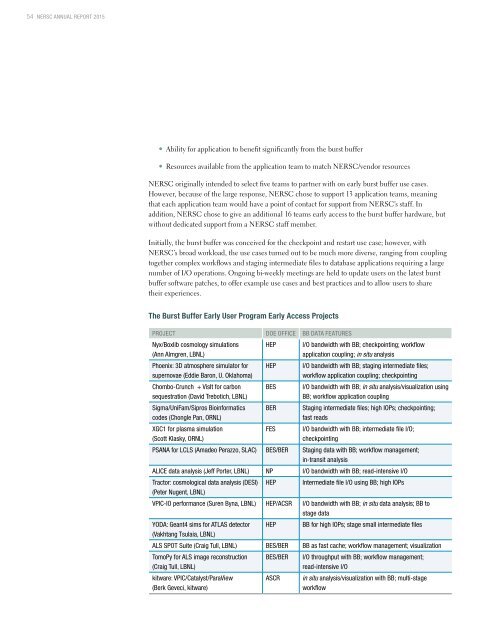National Energy Research Scientific Computing Center
BcOJ301XnTK
BcOJ301XnTK
Create successful ePaper yourself
Turn your PDF publications into a flip-book with our unique Google optimized e-Paper software.
54 NERSC ANNUAL REPORT 2015<br />
• Ability for application to benefit significantly from the burst buffer<br />
• Resources available from the application team to match NERSC/vendor resources<br />
NERSC originally intended to select five teams to partner with on early burst buffer use cases.<br />
However, because of the large response, NERSC chose to support 13 application teams, meaning<br />
that each application team would have a point of contact for support from NERSC’s staff. In<br />
addition, NERSC chose to give an additional 16 teams early access to the burst buffer hardware, but<br />
without dedicated support from a NERSC staff member.<br />
Initially, the burst buffer was conceived for the checkpoint and restart use case; however, with<br />
NERSC’s broad workload, the use cases turned out to be much more diverse, ranging from coupling<br />
together complex workflows and staging intermediate files to database applications requiring a large<br />
number of I/O operations. Ongoing bi-weekly meetings are held to update users on the latest burst<br />
buffer software patches, to offer example use cases and best practices and to allow users to share<br />
their experiences.<br />
The Burst Buffer Early User Program Early Access Projects<br />
PROJECT DOE OFFICE BB DATA FEATURES<br />
Nyx/Boxlib cosmology simulations HEP I/O bandwidth with BB; checkpointing; workflow<br />
(Ann Almgren, LBNL)<br />
application coupling; in situ analysis<br />
Phoenix: 3D atmosphere simulator for<br />
supernovae (Eddie Baron, U. Oklahoma)<br />
Chombo-Crunch + VisIt for carbon<br />
sequestration (David Trebotich, LBNL)<br />
Sigma/UniFam/Sipros Bioinformatics<br />
codes (Chongle Pan, ORNL)<br />
XGC1 for plasma simulation<br />
(Scott Klasky, ORNL)<br />
HEP<br />
BES<br />
BER<br />
FES<br />
I/O bandwidth with BB; staging intermediate files;<br />
workflow application coupling; checkpointing<br />
I/O bandwidth with BB; in situ analysis/visualization using<br />
BB; workflow application coupling<br />
Staging intermediate files; high IOPs; checkpointing;<br />
fast reads<br />
I/O bandwidth with BB; intermediate file I/O;<br />
checkpointing<br />
PSANA for LCLS (Amadeo Perazzo, SLAC) BES/BER Staging data with BB; workflow management;<br />
in-transit analysis<br />
ALICE data analysis (Jeff Porter, LBNL) NP I/O bandwidth with BB; read-intensive I/O<br />
Tractor: cosmological data analysis (DESI) HEP Intermediate file I/O using BB; high IOPs<br />
(Peter Nugent, LBNL)<br />
VPIC-IO performance (Suren Byna, LBNL) HEP/ACSR I/O bandwidth with BB; in situ data analysis; BB to<br />
stage data<br />
YODA: Geant4 sims for ATLAS detector HEP BB for high IOPs; stage small intermediate files<br />
(Vakhtang Tsulaia, LBNL)<br />
ALS SPOT Suite (Craig Tull, LBNL) BES/BER BB as fast cache; workflow management; visualization<br />
TomoPy for ALS image reconstruction<br />
(Craig Tull, LBNL)<br />
kitware: VPIC/Catalyst/ParaView<br />
(Berk Geveci, kitware)<br />
BES/BER<br />
ASCR<br />
I/O throughput with BB; workflow management;<br />
read-intensive I/O<br />
in situ analysis/visualization with BB; multi-stage<br />
workflow


